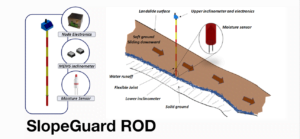An AI-powered landslide monitoring technique which saves lives
Landslides are one of the most frequent geological events worldwide. Between 1998 and 2017, they killed 18 thousand people and affected 4.8 million lives. In addition, landslides caused billions of euros of damage to co...

Landslides are one of the most frequent geological events worldwide. Between 1998 and 2017, they killed 18 thousand people and affected 4.8 million lives. In addition, landslides caused billions of euros of damage to communication and transportation infrastructures. With Italian environmental monitoring devices manufacturer TechCom, Gemmo is bringing a new AI-powered landslide monitoring solution to the market. SlopeGuard combines the best sensing technology with software powered by machine learning to change how landslides are monitored and save lives.
The landslide emergency
Climate change, uncontrolled urbanisation, and deforestation are the main factors triggering the recent increase in landslide disasters. The consequences of landslides are dramatic both in terms of loss of lives and damage. Dealing with the aftermath requires billions of euros and can take years. Despite the urgency, several European countries have not yet implemented proper landslide monitoring solutions. First responders and governmental bodies have often identified the most dangerous landslide sites. Still, they cannot monitor these areas due to lacking human resources and funds.
93% of landslides are shallow events, with an estimated occurrence in mountain areas of 1 every 3 square kilometres. In 2005, a consecutive 3-day heavy rainfall in Switzerland triggered about 5,000 shallow landslides.
We designed SlopeGuard to specifically address the issue of monitoring shallow landslides and preventing large-scale disasters.
Traditional shallow landslide monitoring systems
In the past, the approach to shallow landslides was more defensive than preventive. One of the most common solutions was building defence barriers (human-made or natural by planting trees). However, in recent years, this approach has become no longer sustainable. As a result of the increasing number of heavy rainfall events, the areas which could be affected by landslides have multiplied. For this reason, a reliable monitoring solution has now become a priority.
Most landslide monitoring systems currently available on the market rely on satellite techniques and inclinometers (instruments used for measuring angles of a slope with respect to gravity’s direction.).
Satellite techniques represent the new frontier in landslide monitoring, but they are ineffective in detecting shallow landslides. The dynamic of a shallow landslide is too fast to be tracked by satellites, which usually return a view of the sites every few days. Another issue connected with using satellites is that they don’t always have access to a clear view of the ground because this is hidden by vegetation.
On the other hand, geotechnical approaches using borehole inclinometers are very expensive and hard to deploy and control. The sensors required for landslide monitoring are many and varied, and the analysis of collected data is very complex and time-consuming. This means that when operators understand that an area is at imminent risk of landslide, the damage might already have been done.
Due to the scarcity of funds and the countless lives at risk, the market needs a scalable, low-cost, and easily deployable solution. SlopeGuard’s ambition is to provide this solution and change how shallow landslides are monitored, managed and prevented.
An AI-powered landslide monitoring technique which saves lives
Slopeguard is different from other solutions available on the market because it can detect signs of shallow landslides very early. This novel technique consists of an integrated rod-shaped monitoring station that can easily be inserted into the core of a landslide. SlopeGuard combines the best range of sensors needed to monitor slope movements with a machine-learning algorithm which automatically generates early warnings of landslides 24/7.
We created this new landslide monitoring system to overcome the limitations presented by other solutions. Not only does this new solution allow better identification of the areas which are highly susceptible to landslides, but it is also very affordable and easy to deploy. In addition, SlopeGuard automatically generates recommendations which help operators make timely decisions to minimise landslides’ impact. This means the system enables end-users to manage infrastructures in greater safety and better design and plan defence works.

What are SlopeGuard’s advantages compared to other landslide monitoring systems?
The use of machine learning algorithms represents a significant advantage compared to other landslide monitoring systems because it allows the automation of the data analysis process. To our knowledge, no technique currently available on the market uses AI for landslide monitoring and disaster prevention.
Specifically, SlopeGuard’s novel technology introduces three main advantages:
- Smart decision support: SlopeGuard’s machine learning model automatically analyses and organises geophysical and meteorological measurements to recognise early danger signs. This decision-support system provides operators with substantial benefits in terms of time-saving and responsiveness.
- Increased scalability: SlopeGuard is a multi-site system that can be deployed on a large scale to monitor and secure vast land areas. The solutions currently on the market don’t have this capability.
- Reduced costs: SlopeGuard has very few installation requirements because the measurement sensors are mounted directly at the bottom of the device. This way, SlopeGuard can monitor slope movements close to the core of the sliding plane. This feature significantly reduces the costs associated with using SlopeGuard compared to other solutions that use borehole inclinometers.
When and where will SlopeGuard be available?
The project will kick off in September 2022, and SlopeGuard should be available on the market by October 2023. We plan to start marketing the system in Italy and then expand to the rest of Europe, with North America and the Middle East to follow. We calculated that we are tapping into a €50 billion market that has been largely unexplored and rapidly growing.
With SlopeGuard, we are on a mission to save lives. We want to make a difference in emergency monitoring and contribute strongly to the safety and wellness of our communities worldwide.
Author Manuela Armini



